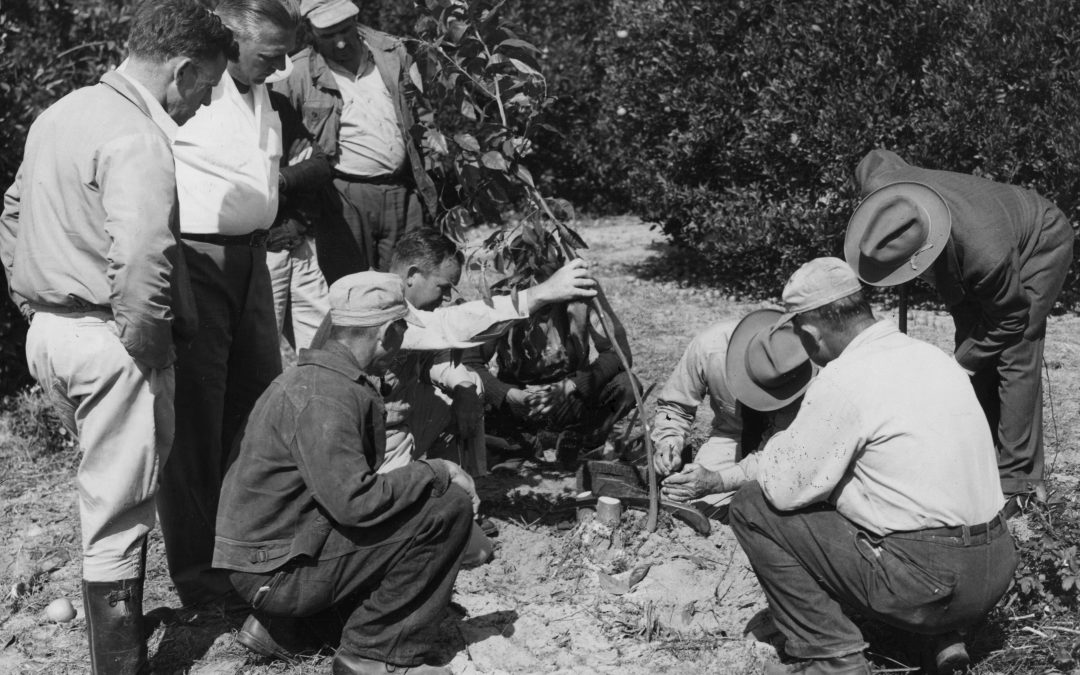
by Matt Lollar | Feb 18, 2021
It’s mid-February, cloudy, and cold. It’s time to get outside and take cuttings for fruit and nut tree grafting. The cuttings that are grafted onto other trees are called scions. The trees or saplings that the scions are grafted to are called rootstocks. Grafting should be done when plants start to show signs of new growth, but for best results, scion wood should be cut in February and early March.
Scion Selection
Straight and smooth wood with the diameter of a pencil should be selected for scions. Water sprouts that grow upright in the center of trees work well for scion wood. Scions should be cut to 12-18″ for storage. They should only need two to three buds each.
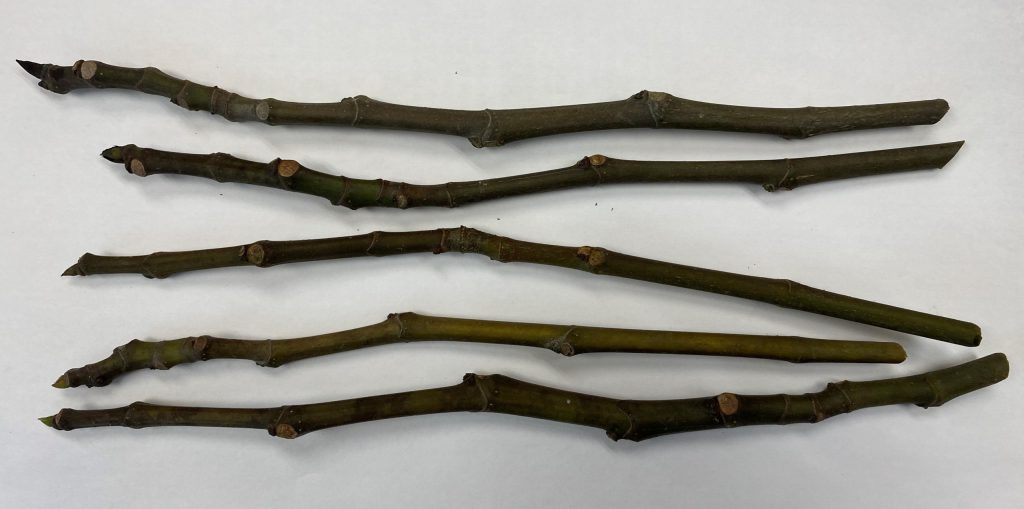
Scions ready for grafting. Photo Credit: Matt Lollar, University of Florida/IFAS Extension – Santa Rosa County
Scion Storage
Scions should be cut during the dormant season and refrigerated at 35-40°F until the time of grafting. If cuttings are taken in the field or far from home, then simply place them in a cooler with an ice pack until they can be refrigerated. Cuttings should be placed in a produce or zip top bag along with some damp paper towels or sphagnum moss.
Grafting
It is better to be late than early when it comes to grafting. Some years it’s still cold on Easter Sunday. Generally, mid-March to early April is a good time to graft in North Florida. Whip and tongue or bench grafting are most commonly used for fruit and nut trees. This type of graft is accomplished by cutting a diagonal cut across both the scion and the rootstock, followed by a vertical cut parallel to the grain of the wood. For more information on this type of graft please visit the Grafting Fruit Trees in the Home Orchard from the University of New Hampshire Extension.
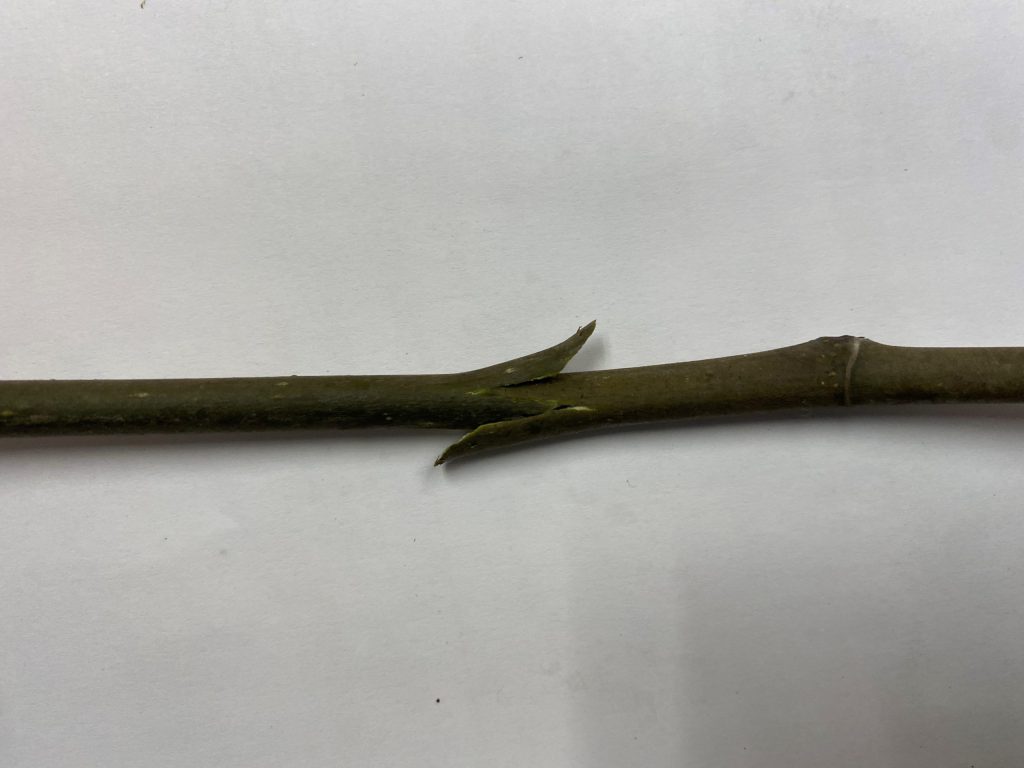
A bench graft union. Photo Credit: Matt Lollar, University of Florida/IFAS Extension – Santa Rosa County
Achieving good bench graft unions takes skill and some practice. Some people have better success using a four-flap or banana graft technique. This type of graft is accomplished by stripping most of the bark and cambium layer from a 1.5″ section of the base of the scion and by folding the back and removing a 1.5″ section of wood from the top of the rootstock. A guide to this type of graft can be found on the Texas A&M factsheet “The Four-Flap Graft”.
Grafting is a gardening skill that can add a lot of diversity to a garden. With a little practice, patience, and knowledge any gardener can have success with grafting.
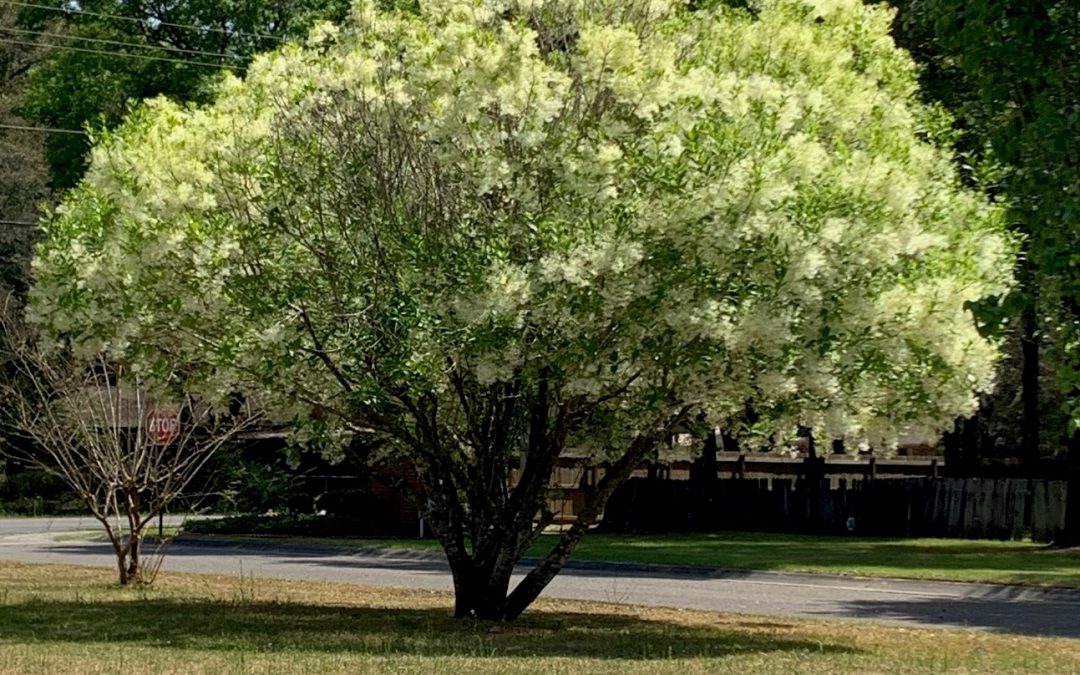
by Mary Salinas | Feb 18, 2021
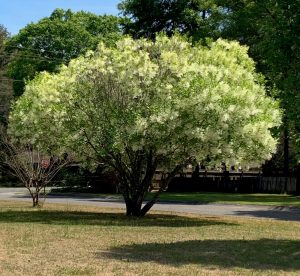
American fringetree Chionanthus virginicus), a native deciduous small tree with delicate blooms in spring. Photo credit: Mary Salinas, UF/IFAS Extension.
January and February are ideal months for adding a tree or two to your landscape in the Florida panhandle. In the cooler weather, the ground stays moist for a longer time, which helps prevent drought stress and the drying out of the rootball. Also, the winds are generally milder, and the tree will have a chance to get established and anchored in before the wilder winds of summer roll in.
Before investing time and money in a tree, take a few minutes and be sure that the species you choose is right for your particular landscape.
Here are some things to consider:
- Whether the area can accommodate the ultimate size of the tree, both height and width, and not grow into overhead wires, streetlights, or your house.
- Are there any underground utilities or septic? A call to 811 can check on where your utilities are.
- The hardiness zone for the tree. Be aware that zone 8 or 9 in the western United States is a different climate with respect to moisture than the same zone 8 or 9 in Florida.
- Whether the tree can thrive in your soil – sandy, loam or clay, loose or compacted, high and dry, or wet and low.
- The amount of sun it requires.
- Whether you want native species that provide food and habitat for native birds and animals.
- Salt-tolerance if located on the coast.
- Wind tolerance, especially if located on the coast. Many fast-growing trees are brittle and susceptible to breakage.
- Whether you prefer an evergreen or deciduous tree. Evergreen trees, like hollies, provide a natural screen all year while some deciduous trees, like maple and bald cypress, provide fall color.
- Is the tree messy, dropping large seed pods, fruit, or leaves?
- The color and shape of leaves and flowers and other ornamental qualities.
- Whether the tree species has known disease or pest issues.

Florida red anise (Illicium floridanum), a small tree/large shrub for shady locations. Photo credit: Mary Salinas UF/IFAS Extension.
Once you choose what species of tree you will add to your landscape, here’s information on Selecting Quality Trees from the Nursery.
Optimum tree health and vigor also depends on the correct methods of Planting and Establishing Trees.
And this site has even more comprehensive information on trees and shrubs: University of Florida/IFAS Landscape Plants.
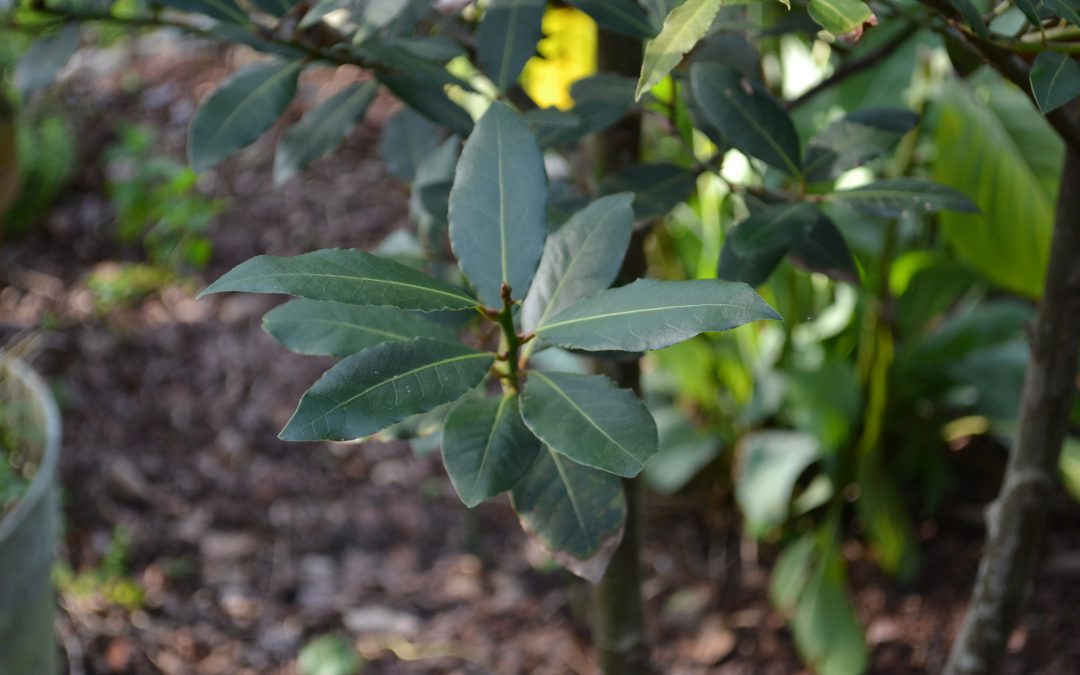
by Beth Bolles | Feb 11, 2021
Escambia County Master Gardener Volunteer Carol Perryman shares information for you to consider growing your own Bay laurel tree.
Laurus nobilis, commonly known as bay laurel, is an aromatic tree native to the western Mediterranean and it yields the bay leaves used in cooking. Mature leaves are leathery and dark green. Most are 3 to 4 inches in length with minute margin serrations. Small, inconspicuous yellowish-white blooms may appear in summer followed by a tiny fruit which turns black as it dries. Bay laurel is salt tolerant and can be grown on barrier islands.
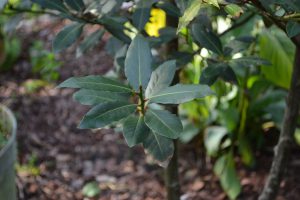
Dark green bay leaves. Photo by Beth Bolles, UF IFAS Extension Escambia County.
The bay laurel tree is called daphne in Greece. Greek mythology says that Apollo, the sun god, fell in love with the nymph Daphne. Her father took action and turned her into a laurel tree. To remember Daphne, Apollo wore a laurel wreath and the tree came to represent honor and glory. Greek and Roman heroes and scholars were crowned with laurel wreaths. The earliest Olympic champions in 776 BC wore garlands of fragrant bay leaves. The tree was considered good luck, but the death of a bay tree was considered an omen of things to come.
Bay laurels are slow-growing and show variation in growth habits. Most have a dense and shrubby appearance with multiple shoots from the base while some have a single trunk. Under ideal conditions, planted in the ground, the bay tree can reach 25 feet or higher, but most commonly grow to about 6 feet. In our zone, 8B, bay laurels can grow in the ground if planted in a sunny southern or eastern exposure location near a wall or building for cold protection.
Bay laurel plants like well-drained, rich soil. If the bed is properly prepared, additional fertilizer is rarely needed. Bay laurels will survive light frosts and the infrequent hard freeze if it is not for a prolonged period. More mature trees can also freeze to the ground and come back from the rootstock. Young trees should be protected from cold stress for several years until they are at least a foot tall before planting in the ground.
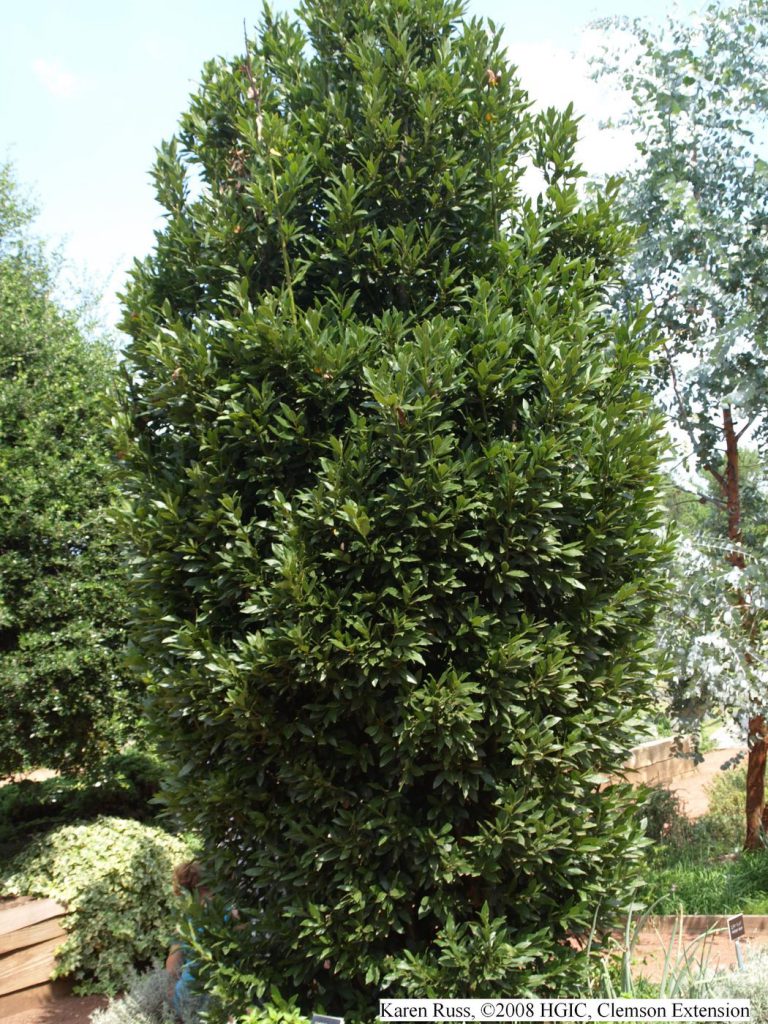
A bay laurel trained as a tree. Photo Credit: Karen Russ, Clemson University Extension
Bay laurels can also be grown indoors in containers in areas with strong natural lighting. Clay or wooden containers with many drainage holes are preferred. Plants should be fertilized regularly with complete fertilizer. In the summer, time-release fertilizer works best due to frequent watering. However, fertilizers too high in nitrogen will produce lush foliage with little flavor.
Bay laurel is a favored container-grown street plant in Europe. It has historically been found in gardens as a tree, a hedge, a topiary, or a focal point in an herb garden. Bay trees are only now gaining popularity in the United States. It was awarded the herb of the year in 2009.
Bay laurel has a reputation of being frustrating and difficult to propagate which results in very high prices for starter plants. To propagate use semi-hard wood cuttings and snap from branches rather than clipping. Strip the lower leaves and dip cutting in a rooting hormone. Stick in small pots filled with a fine-textured medium. If a knob forms at the end in a few weeks, then roots may form within a few weeks to several months. In recent years, plants have been more readily available in nurseries and even at large box stores.
Bay laurel is one of the primary culinary herbs in the garden. The culinary history has been documented for thousands of years. The leaves are treasured and used in many cuisines. Fresh leaves are tough but dried leaves are hard and brittle. Leaves are added at the beginning of cooking. Both fresh or dried are usually removed after cooking before food is served to prevent the risk of choking. Much is said about fresh versus dried bay leaves. I usually use fresh leaves because I have them available. I think they have a wonderful flavor. I use equal amounts of fresh or dried. Soft fresh leaves (petioles and midribs removed) are great chopped in salad dressings. Chopped leaves are also good in butters and cheeses with other herbs. Cajun cuisines use bay leaves to flavor rice and seafood. Bay is a primary element of bouquet garni, a bouquet of herbs, used in French cuisine. Bay goes in meats, soups, stews, vegetables, pasta, potatoes, and sometimes in custards and dessert sauces. Like parsley and marjoram, bay laurel is called a “liaison” herb which helps contrasting herb flavors blend rather than fight each other.
There are many plants that look like and smell like the bay laurel. Red bay, Persea borbonia, is native throughout our region and a substitute for bay laurel. Red bay is best used fresh. Its fragrance and flavor dissipate quickly if dried. This is one of the only substitutes. Others are poisonous or have little to no flavor. Madalene Hill and Gwen Barclay, authors of Southern Herb Growing, wrote, “A word to the wise: Be wary of collecting and using any wild plant as flavoring or food unless you’re absolutely sure of its safety. Just because a plant is called some type of bay or laurel does not mean it is edible.” Some are highly poisonous.
If you enjoy good food, you have enjoyed bay laurel, Laurus nobilis, whether you knew it or not. It’s time to grow your own beautiful and fragrant bay laurel tree. This will be a wonderful addition to your garden and to your kitchen.
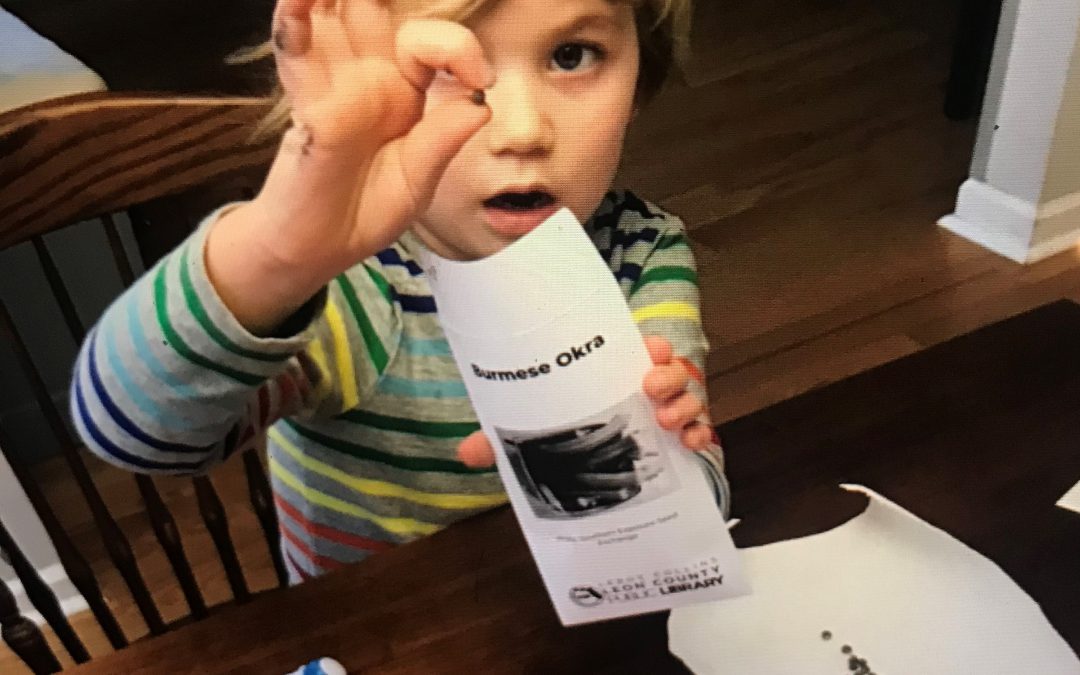
by Molly Jameson | Feb 11, 2021
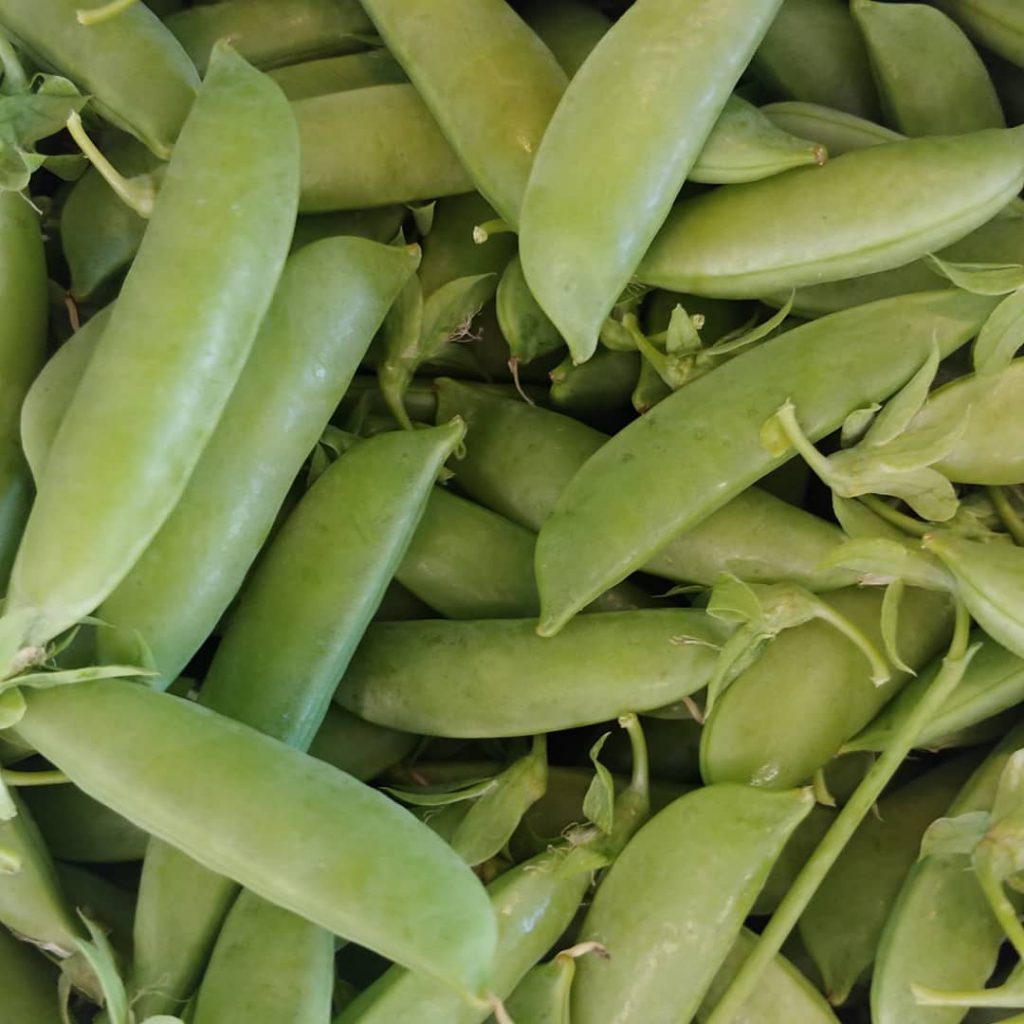
Sugar snap peas prefer to be planted when the soil is cool and the pods are delicious raw or cooked. Photo by Full Earth Farm.
Leon County’s Spring 2021 Seed Library Program Starts February 13
Although we are still experiencing the coolness of winter, the spring gardening season is right around the corner. To get a head start on the heat that will start taking over by May – and certainly by June – it is important to have a spring garden plan. If you want to start your veggies from seed, certain crops, such as tomatoes, need to be seeded soon for best results. Other warm-loving crops, like squash and cucumbers, also benefit from an early start to beat the life cycles of many common pests.
Need seeds to start your garden? Well, if you live in Leon County, you are in luck. Starting on February 13, 2021, residents of Leon County can “check out” up to three sample seed packets per month with their library card as part of Leon County’s Seed Library Program. The vegetable seeds can be checked out from any of the seven library branch locations. Leon County residents can apply for a library card online at the LeRoy Collins Leon County Public Library online card application page (https://lcpl.ent.sirsi.net/custom/web/registration/).

A young volunteer helped pack seeds from home for the Spring 2021 Leon County Seed Library Program. Photo by Jeanne Breland.
Here are the vegetable seed varieties that will be available starting February 13:
- Italian Large Leaf Basil. This is a fast-growing plant, with four-inch-long green leaves that have an anise flavor and a sweet aroma.
- Jackson Wonder Butterbeans. A high yielding heirloom, these beans produce pods with three to five reddish colored beans in each. When dried, the beans develop a mottled pattern.
- A & C Pickling Cucumber. Plants are productive, producing many straight, dark-green fruits that are great for pickling when they are four to six inches long. Eaten fresh, they can be grown out to 10 inches.
- Edisto 47 Melon. Plants prosper in hot, humid climates and produce mildly sweet five-pound cantaloupes in about 90 days.
- Burmese Okra. Plants have very large leaves and at about 18-inches tall, produce slender curved 9 to 12 inch okra pods that are virtually spineless. Under 10 inches, pods can be eaten raw and are less viscous than some other varieties.
- Sugar Snap Peas. Plants produce sweet, crisp pods that can be eaten raw or cooked. Seeds germinate well in cool soil and plant growth is vigorous, requiring support.
- Corno di Toro Sweet Bell Pepper. This productive pepper, whose name translates to “Horn of the Bull,” produces thick horn-shaped fruit that is flavorful and great eaten raw or cooked.
- Butternut Waltham Squash. This winter squash produces four-to-five-pound fruits with necks that are thick, straight, and cylindrical. The flesh of the fruit is smooth and has a flavor that sweetens with storage.
- Black Krim Tomato. This Russian heirloom has indeterminate growth and produces 8 to16 ounce, brown-to-red fruit with a deep smoky flavor. The shoulders of the tomatoes are brownish green and darken with more heat and sunlight.
- Matt’s Wild Cherry Tomato. This deep-red small cherry tomato has indeterminate growth and produces soft fruit that is very sweet and full of flavor.
Whether you are located in Leon County or not, everyone is welcome to join us Saturday, February 13, from 10:00 a.m. to 12:00 p.m., for our Leon County Seed Library Virtual Workshop. Via Zoom, agents with UF/IFAS Extension Leon County will discuss spring vegetable gardening techniques and food waste prevention. There will also be a live cooking demonstration showing how to prepare healthy meals and snacks at home, featuring vegetables available in the Spring 2021 Seed Library Program.
For more information about the Leon County Seed Library Virtual Workshop, please visit our Eventbrite page: https://spring2021leoncountyseedlibrary.eventbrite.com. There is no cost to attend the workshop, but registration is required.
Happy spring gardening!
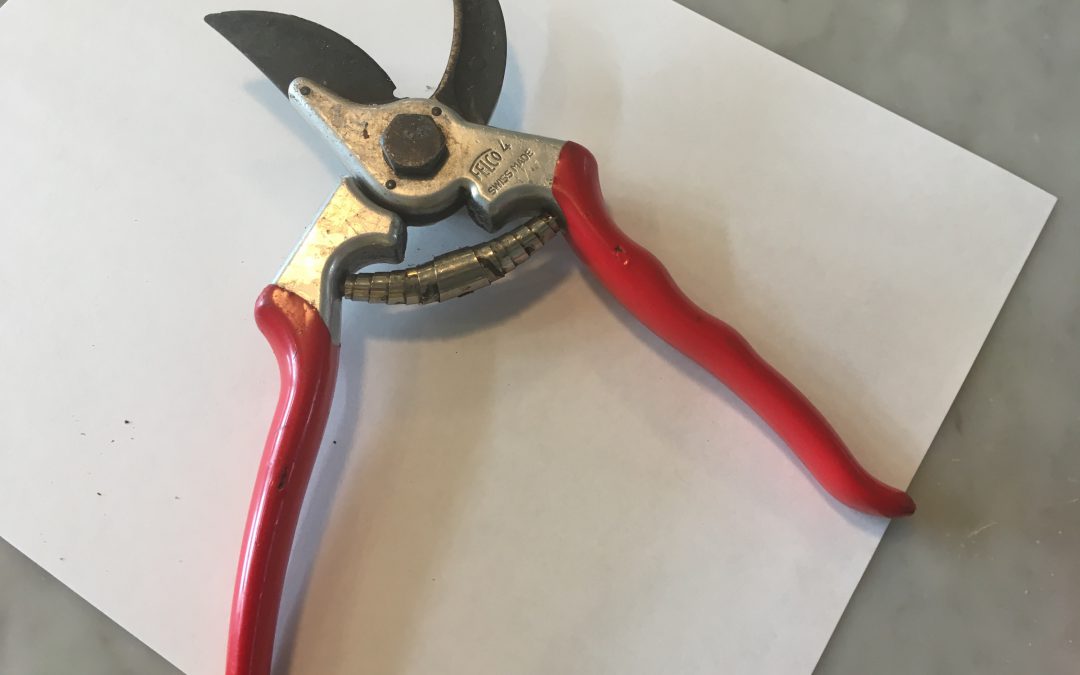
by Daniel J. Leonard | Feb 2, 2021
There is an old saying that rings true in pretty much any situation – “You get what you pay for.” Gardening tools, especially pruners, are no exception. We’ve all been there, fumbling around with a pair of rusty, dull, cheap garden pruners that just barely get the job done. Unfortunately, they can also do considerable harm to the plants you’re trying to improve, as anything short of a nice, sharp, clean cut introduces the potential for insect/disease infestation and will produce a wound that takes much longer to heal, if it ever heals properly at all. You wouldn’t want your doctor to start hacking away at you with a dirty, second-rate scalpel. Don’t subject your plants to the same treatment! While I’m not advocating blowing hundreds or thousands of dollars outfitting your garden tool shed with top of the line everything, investing in a pair of quality bypass hand pruners will pay dividends many years into the future and make your gardening experience much more enjoyable!
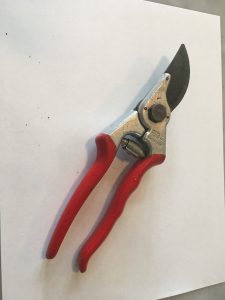
The classic Felco #4 bypass hand pruners. Photo courtesy of Walton County Master Gardener Andrea Schnapp.
Found in three designs, from old-fashioned anvil pruners that smush and smash their way to a cut, to ratcheting pruners that make short work of larger branches but tend to be cumbersome and complicated, to bypass pruners that produce clean cuts in a scissor-like manner, hand pruners accomplish many tasks in the landscape. From cutting small limbs, to harvesting vegetables, to deadheading annual flowers and everything in between, there isn’t a more frequently used, versatile tool. Therefore, it makes sense to buy a quality pair that will perform excellently, still be snipping long after your pruning days are over (if you take care of them), and that are comfortable enough you will enjoy using them. When shopping for your pair of “forever” pruners, there are a few things to look for.
- Only use bypass style pruners. Your plants will appreciate it.
- Look for heavy duty pruners with frames made from quality aluminum or stainless steel; they won’t rust and won’t easily bend or break.
- Buy pruners with replaceable parts. This is especially key because springs eventually rust and gum up and blades break and will eventually lose their ability to hold an edge over time (though you can and should resharpen them).
There are two commonly found brands that fit all three above criteria, albeit at different price points. For a high quality “budget” blade, various models from Corona do an excellent job for the money ($20-30) and won’t hurt your feelings too badly if you happen to lose a pair. Should you decide to splurge a little, Felco makes sharp, indestructible pruners, in multiple models around $50 to fit all size hands. Felco has become the horticulture industry standard and you’d be hard pressed to find a nursery owner or landscaper that didn’t own a pair (or two).
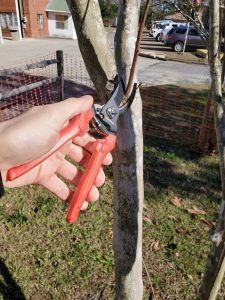
Corona ComfortGel bypass hand pruner. Photo courtesy of Daniel Leonard.
Regardless of which brand you buy (and there are many more than the two above listed) a pair of well-made pruners, if taken care of, should last a lifetime and make your gardening experience much more enjoyable for you and your plants! If you have any questions about gardening tools or equipment or any other horticulture or agronomic topic, feel free to contact your local UF/IFAS Extension Office. Happy Gardening!
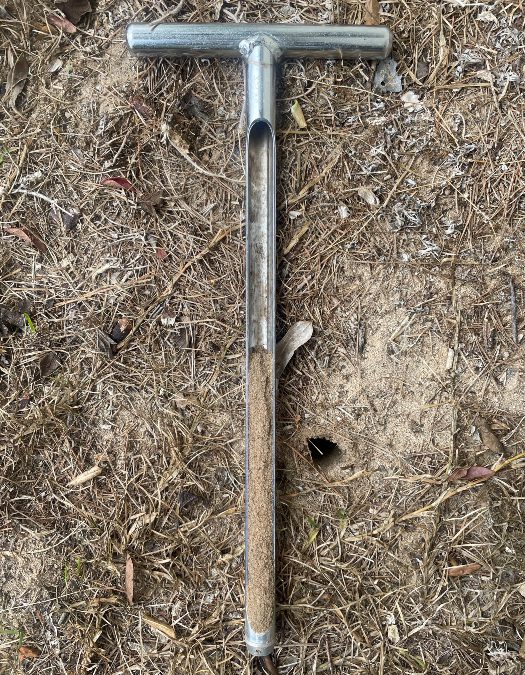
by Pat Williams | Jan 22, 2021
For all my years in the classroom, I never let students say the “d-word” when discussing soil science. In some instances, we had a “d-word” swear collection jar of a quarter when you used the term and even today, I hesitate from spelling the word out in text due to feedback from all those I have corrected. In case you still need a clue on the “d-word”, it ends in irt.
As a horticulturist for 46 years, I have read, heard, and been told many secrets to growing good plants. I still hold firm that without proper knowledge of how soil works, most of what we do is by chance. Soil is a living entity comprised of parent material (sand, silt, and clay), air, water, organic matter (OM), and microorganisms. It is this last item which makes our soils come to life. If you have pets, then you know they need shelter, warmth, air, water, and food. From this point forward think of soil microorganisms as the pets in your soil. If you take care of them, they will take care of your plants.
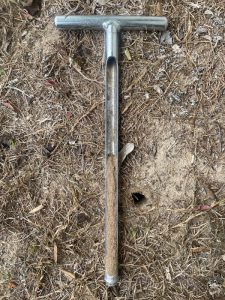
Sandy soil without any organic matter at the Wakulla County Extension office.
There is a huge difference in habitat from a sandy soil to a healthy soil with a good percentage of OM (5% – 10%). In one gram of healthy soil (the weight of one standard paper clip), you can have bacteria (100,000,000 to 1,000,000,000), actinomycetes (10,000,000 to 100,000,000), fungi (100,000 to 1,000,000), protozoa (10,000 to 100,000), algae (10,000 to 100,000), and nematodes (10 to 100) (1). A teaspoon of healthy soil can contain over four billion organisms (2). These microorganisms are part of the soil food web and they form a relationship between soil and your plants. They help convert nutrients to useable forms and assist with other plant functions.
The question becomes how to take care of your soil pets. For years we have performed practices that compromise these populations. Growing up we put all of our grass clippings in the weekly trash. We know now how valuable those clippings are and to leave them be. Two practices still common today though are tilling and raking leaves.
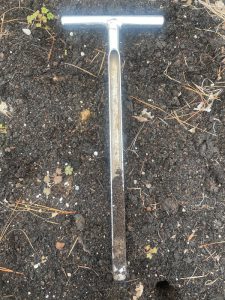
Master Gardener Volunteer vegetable bed with organic matter added.
Tilling has a limited purpose. If I place a layer of organic matter on top of the ground, then tilling incorporates the OM which feeds my pets. Excess tilling of soil introduces large amounts of oxygen which accelerates the breakdown of OM thus reducing our pet populations over time. Another adverse result from tilling is disturbing the soil structure (how the parent materials are arranged) which can reduce pore spaces thus limiting water percolation and root growth. There is a reason agriculture has adapted no-till practices.
Raking leaves (supposedly the sign of a well-kept yard) is removing large amounts of OM. Do you ever wonder why trees in a forest thrive? All of their leaves fall to the ground and are recycled by the microorganisms. Each of those leaves contains macronutrients (carbon, hydrogen, oxygen, nitrogen, phosphorus, potassium, calcium, sulfur, and magnesium) and micronutrients (boron, copper, chlorine, iron, manganese, molybdenum, nickel, and zinc) which are necessary for plant growth. You would be hard pressed to find all those nutrients in one fertilizer bag. So recycle (compost) your leaves versus having them removed from the property.
We are in our off season and tasks such as improving soil health should be considered now for soils to be ready in spring. Remember a little organic matter at a time and never work wet soils. As your OM levels build over the years, remember to change your watering and fertilizing schedules as the soil will be better adapted at holding water and nutrients. Soil tests are still recommended before fertilizing.
If you would like more tips on improving your soil, contact me or your local county horticulture extension agents. For a more in depth look at caring for your soils, read The Importance of Soil Health in Residential Landscapes by Sally Scalera MS, Dr. A.J. Reisinger and Dr. Mark Lusk (https://edis.ifas.ufl.edu/ss664).
- Chapter 2: Soils, Water, and Plant Nutrients. Texas Master Gardener Training Manual.
- The Importance of Soil Health in Residential Landscapes. 2019.


















